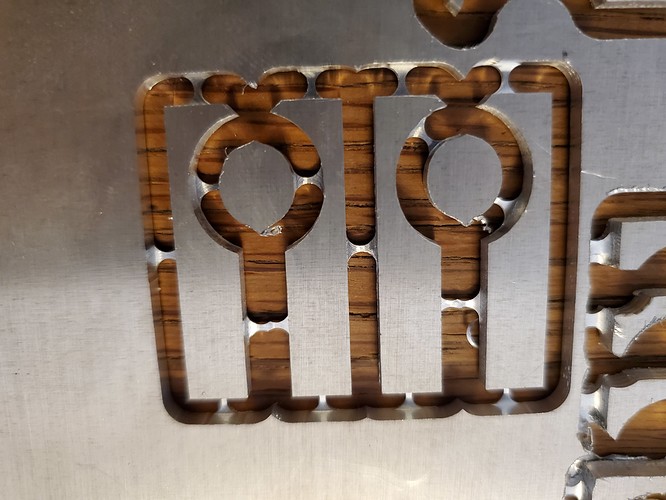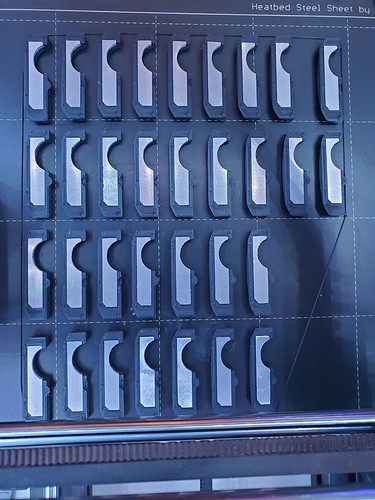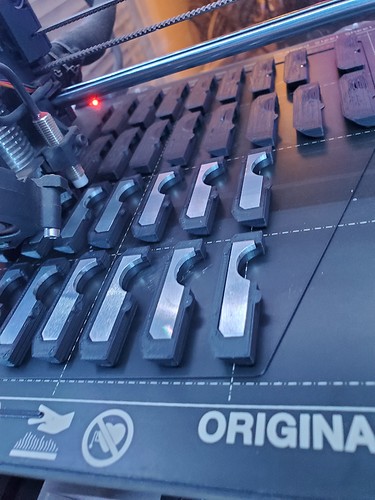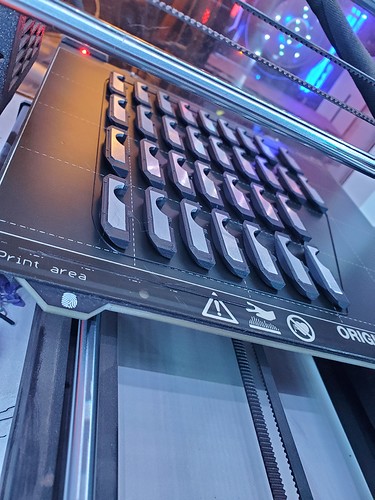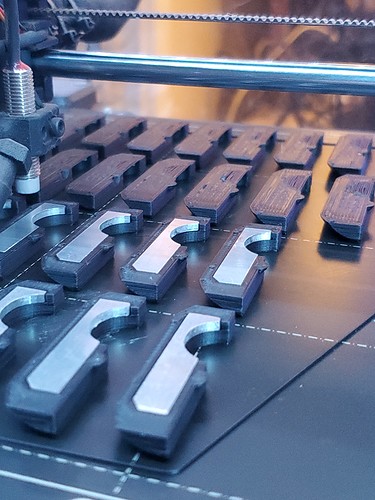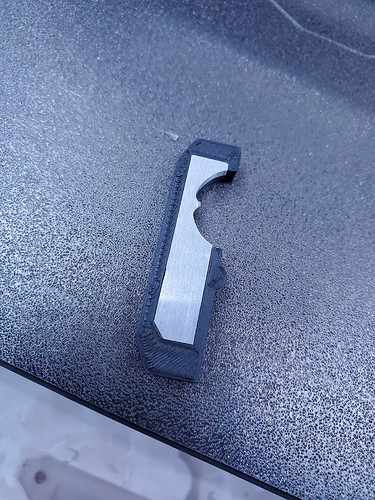Jamie, part of my concern is a rail less design where sawdust or debris can get on the wheel surface and create defects, or the unit moving out of square over time. I plan on limit switchs and homing the unit each time. I have also been toying with a driven wheel system to eliminate belt stretch or belt skipping. Perhaps I am overthinking it. but hearing .1mm is repeatable is encouraging.
Perhaps. ![]()
Another way to think of it is depending on the size of items you anticipate cutting is there another sub $1k cnc you know that will cut full sheets this well? 
At this size it’s a very unique option.
Again, I am not dissing the LR2, rather simply seeking to find it’s design limits and what has been found by others. Again, my goal is to have realistic expectations of it so once built I am not disappointed.
I’m concerned about your intentions to use this as a commercial production machine. I enthusiastically encourage you to build one as I know from experience a full sheet lowrider is a capable machine, especially when considering its humble inputs. However, your comment about hours of operation with a high degree of flawless parts… hmm. I think you’d be better off buying a machine that has commercial production capacity in mind.
Thanks for sharing your thoughts. However holding 5 thou isn’t commercial grade. Holding .5 thou is commercial grade for a mill. I have worked on Bridgeport, Haas and a few others but they are way overkill for this project and obviously they can’t do sheet goods. Again, my goal is managed expectations. If I am cutting a project from 3/4" 13ply baltic birch, it’s going to take a while as they can’t be hogged out with a half inch mill. This all needs to be done with an 1/8" mill. So that means lots of passes and slower feed rates. So this project could be an all day job. BUT if the mechanics are solid, it shouldn’t be an issue.
If it becomes an issue I will build LR5 with linear rails, captive wheels, all parts Aluminum, tighter bearings, bigger steppers and thicker tubing or 8020 to get the spans with no droop. BUT before I go all crazy, and blow my budget, Want to get a baseline read on what others are finding and experiencing then I can make my decision. From what I am reading from others, getting to .1m shouldn’t bee too hard. atleast doable. So I continue to enjoy people’s views.
All of the aforementioned attributes mentioned by a variety of experienced users with the lowrider are valid. I can personally vouch for and hold tolerances in the realm of what you are seeking with ease on a full sheet low rider, however - my previous post isn’t about specs/tolerances its about end user durability over hours and hours of use. I frequently make large cuts that take hours, but not hours and hours on end. At some point a PLA part will crack, or a motor may fail for some reason, etc. My primary suggestion is to augment your expectations and to include durability as a metric in your decision making.
I applaud your efforts to manage expectations beforehand and I think the lowrider is a knock-your-socks-off great deal at the ridiculously low entry price point it happens to be at.
And if production time is valuable, have spares on hand for the parts most likely to fail so that repairs can be started immediately.
And that is why I am likely to not use PLA parts beyond the time it takes to get them made from a more durable material that isn’t hydroscopic and susceptible to stress both thermally and mechanically. PLA is a great material for folks looking to print their own parts for sure. I am likely going to use the PLA parts as mold forms for a pour of a less brittle material that has better heat resistance. Motor failures is simply a case for spares. One can easily track the hours on a stepper and compare to mfg life testing results to know when end of life might come. Also their MTBF data is helpful to determine probable failure modes and times.
If you do happen to make a cast part make sure to post a pic.
Steppers motors will be the last thing to fail.
Also, to clarify, 0.1 mm repeatability under minimum load is easy. Achieving 0.1 mm accuracy under realistic loads is not as easy. But in principle if you have repeatability you can tune in the accuracy, which I did in pursuing some tight-fitting finger joints a while back.
Also in regards to PLA vs. other materials, the natural flexibility of the parts is part of the design, so the rollers deflect enough to grip the rails not too loose, not too tight. Casting or milling the same parts out of aluminum will not have the same ability to accommodate imperfections in the rails for example. High stiffness in the parts means tiny errors in rail diameter lead to very high gripping tension or slop, both of which are bad. A lower stiffness material like ABS or PETG will work okay but the machine will be noticeably softer overall and that can lead to more deflection under load and worse accuracy.
I think it is commendable that you are doing your research before going all crazy and blowing your budget, as you said. I suggest that one of the big advantages of the LR2 or MPCNC is that it is cheap enough that the cost can be justified as pure learning, even if you suspect that certain areas are not suitable for your eventual application, you can build it and find out for sure. Some of the concerns might be real and others might be paranoia, and it’s hard to tell in advance which are which.
I always enjoy reading your point of view Jamie.
As Drax or any other user of the V1 products venture forth and form a for-profit enterprise, the incorporation of risk management strategies to production continuity is essential. Bottlenecks often manifest as a result of success and if a failure occurs in a unaccounted for item, system, person, etc. the outcome can result in lost opportunity, lost revenue, or complete loss of capacity. More pointedly, the most durable/dependable parts such as stepper motors still must be accounted for in a risk magnitude assessment. E.g., Stepper motor failure, while not probable, is a production cessation failure event. Tom mentioned having spares on hand…, which happens to be the solution in this case to low probability, high magnitude risk components. Now, if only we could direct this conversation toward risk/reward and capital acquisition… but, that is another forum.
In closing this little diatribe of mine. If in the end the effort results in a great learning experience, then the outcome is priceless.
Jamie,
If I moved from PLA to metal then several things would likely change also. Tubing would be trued and likely a thicker wall to inhibit binding or slop. The parts might be dotally changed to accommodate a linear slide with linear bearings. The hydroscopic nature of PLA is a little concerning as if I adapt a water cooled laser or spindle, a leak could be not a great thing for PLA parts.
Again, I am not absolute in the things I am discussing, my major concern is having the right controller at the heart. Then things like PLA, Tubes, and the motion slides can all be approached on an as required basis. I am drawn to the LR2 because of cost and the expansion ability of the CNC to accommodate sheet goods. It is attractive as it is, but I also know I might be pushing the envelope a bit so I want to be prepared.
@highprobability I get it, and I even agree. Committing to a deadline and then missing it due to a machine failure can be very costly not just from revenue directly but also embarrassment and reputation. I still think a wiring harness is at least 10 to 100 times more likely to fail than the stepper motor itself, but the point is taken: downtime is very costly and perhaps an entire backup machine is justified.
Also from the business angle there has been talk over the years at my company about Discovery-Driven Planning (e.g. https://hbr.org/1995/07/discovery-driven-planning). The gist as far as I can tell is that sometimes it’s expensive or impossible to make accurate predictions, and the business plan is therefore to maximize learning instead of minimizing risk. Maximizing the chance of success might lead to a failure with not much learned, whereas aiming for learning could have a low chance of meeting requirements the first time, but result in a much better position for a second attempt.
I guess my point is that jumping in and experimenting is not unique to a risk-tolerant hobbyist mentality where requirements and schedules are loose. It can be instrumental to minimizing risk and cost and schedule for businesses.
Speaking of risk, there is another risk that has not been mentioned here yet, which is that fires can start very quickly. There are several things that can start a fire and they can’t all be prevented with 100% certainty, so the guidance is that you must babysit the machine while it is operating. This could be a major hit to business productivity. For unattended operation, it could make sense to run an extension cord to the middle of a parking lot, in which case the worst outcome is loss of the machine. This should mitigate the chance of damage to a facility or God forbid injury to a person from fire.
That was a good read. A discussion I always have with a budding entrepreneur is about just starting to start and moving through the steps while accepting the outcomes as necessary towards growth. Not necessarily aligned with the HBR article you linked, but a parallel. And a quick tangent. I love how business professors fix certain variables to explore one or two then extrapolate a solution (and we’re often lucky) to suggest a consultancy for.
What I feel obliged to pound (perhaps into the ground) is that there is a dedicated field of study with application as it applies to risk. Risk management as a process, risk strategies, and so on. Without getting too far astray I’d like to impart a mode of thinking which accommodates risk as a process and incorporates techniques to avoid, reduce, transfer, or accept the outcomes.
It’s easy to think that what you need is bigger, stronger, more accurate, more expensive. When in reality, my biggest limitation is the strength between my ears and the most important tools are the mouse and keyboard.
The machine is really a good balance and a lot of thought has been put into using bearings on tube vs. other linear rails. Belts vs. leadscrews, etc. Printed parts vs. molded or milled metal parts. It isn’t perfect, but in most cases, replacing stuff with something “better” won’t improve anything. It often makes it worse. And the energy and thought that goes into changing it means less time spent learning CAM or CAD or doing testing to dial in settings.
I am an expert at my job. I have 15 years experience and a masters degree. When I start a hobby, I have an assumption or bias that says I’m going to succeed at it. I also make a pretty good living and I can afford good tools. I have to consciously fight the desire to just buy the best tools. The problem isn’t usually the tools. The problem is my inexperience. A new cabinet maker table saw can’t make a desk any better than used table saw on craigslist can if I don’t know what I’m doing.
How is this for repeatability and accuracy?
There was lots of trial and error but they all fit snug like this guy now
Nice! But what the heck are you making?
Wrong answers only!
These are clearly resuable flossers.
Bottlecap chuckers!
